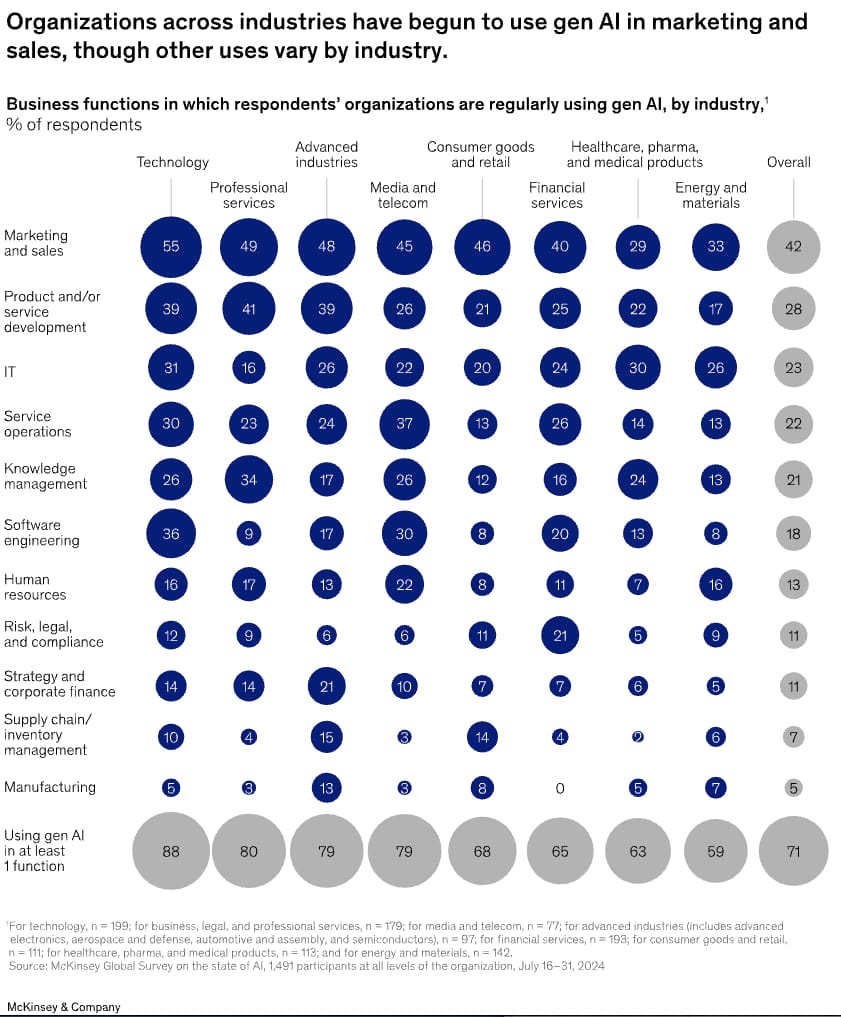EMS Industry Will Be Dragged Kicking and Screaming Into AI

I posted a watered-down version of this post on Linkedin. I want to share it with subscribers because it got a lot of interest there. I had to pick a title to publish this post. I think it fits. I added some additional context here for subscribers.
The graph below, which I also published on Linkedin, is part of a recent McKinsey report, titled: The state of AI: How organizations are rewiring to capture value.
Some industries and businesses take more risks than others. From my experience, contract electronics providers are some of the most risk averse organization in the semiconductor manufacturing supply chain.

Contract EMS manufacturers avoid risk and rarely put investments ahead of revenue without a signed customer PO in place. To put this in perspective, semiconductor manufacturing technology is 18 to 24+ months ahead of electronics original equipment manufacturer (OEM) tech and semi tech is 36 to 48+ months ahead of tech in contract electronics manufacturing industry. EMS companies are laggards when it comes to understanding and investing in new technology. One exception to this is Foxconn with its recent announcement for FoxBrain.
Providers will claim they thin margins and capex projects are NRE for customers committed to the provider but that's not true. Many EMS business functions are profits centers. Take EMS buffers, stores and warehousing, for example.
Regarding the graph above it would be more interesting to see manufacturing broken down by industry and company type: OEM, EMS and ODM, non-OEM components manufacturers.
Many EMS providers pride themselves on saving costs and to do so often build frankenware and add lots of third-party systems on legacy, antiquated systems to solve problems. Few understand what AI is or what it might be capable of achieving. I've witnessed AI help a top 50 EMS provider reduce OEM new program launch to four days, for full-ramp manufacturing production, compared to 14-21 days, previously, yet the provider remained hesitant. This was a few years ago and AI progress in EMS industry has not moved much since then.
AI depth is not yet common among EMS companies. Demand is little for EMS providers seeking technical competence to fill positions related to AI agents and AI systems. This will change. A few tier-2s tried a few years ago. This time will be different. Upper-tier providers who can convince themselves they can afford to take on more risk will be the first wave.
I predict in 2025 a surge of EMS providers will be in a rush to implement AI to remain relevant. More OEMs and OEM customers will want to know EMS providers are optimizing services and decision-making for deeper program visibility, savings and cost reductions - driven by AI - to make their supply chains more competitive and protect their valuable income and profits.

I see investors and shareholders adding to the OEMs wanting AI in EMS supply chains. Some OEMs will change providers when they realize how poorly-managed many EMS providers are in terms of EMS industry financial and operational benchmarks. Debt-to-equity among EMS provider is growing, especially for the more vertically integrated middle-market EMS providers facing (still) tight credit markets. More EMS companies, particularly those serving non-traditional markets, will become M&A targets for PE and LP investors - who will then deploy AI agents and AI systems into their new investments.
_________________________________________________________
About
What matters when formulating contract electronic strategy? How do you identify supplier profit centers and what are you doing to protect against margin erosion for your outsourcing programs? Why do provider capabilities often not match capabilities they claim? How are you benchmarking your supply chain against competitors?
I’ve spent 25+ years in contract electronics industry setting up contract electronic divisions and running operations, protecting EMS program profits, manufacturing capacity M&A and more. I run a technology solutions firm. A lot of times this means asking the right questions.
_________________________________________________________

